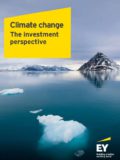
Bron
EY
The risks posed by “stranded assets” — assets that unexpectedly lose value as a result of climate change — are rapidly climbing the investment industry’s agenda. The 21st Conference of the Parties (COP 21), held in Paris during December 2015 and ratified in early October 2016 by 74 signatories, has propelled global warming towards the top of the financial services agenda. Even so, the sheer scale of the issue makes it a challenging one for many institutions.
Financial institutions face many interrelated and highly complex climate-related risks. On the upside, research suggests that investment opportunities arising from the energy transition will actually outweigh climate-related risks in the long term. If commitments to limit global warming are to be fulfilled, then the coming decades will see a worldwide “energy transition” with vast financial implications.
While action on climate change has come a long way, there is still more to be done and Financial Services play a key role in achieving the Paris Agreement. Addressing climate change requires collective action and collaboration across the investment value chain. But individual institutions bear ultimate responsibility for managing climate-related risks and opportunities on behalf of their clients and their own shareholders. Those that respond proactively will create value for their clients, give themselves a competitive advantage, reduce systemic financial risks and make an invaluable contribution to society as a whole. However, those who fail to take action will soon experience the implications across the whole investment value chain, resulting in significant costs and damage to economies.



